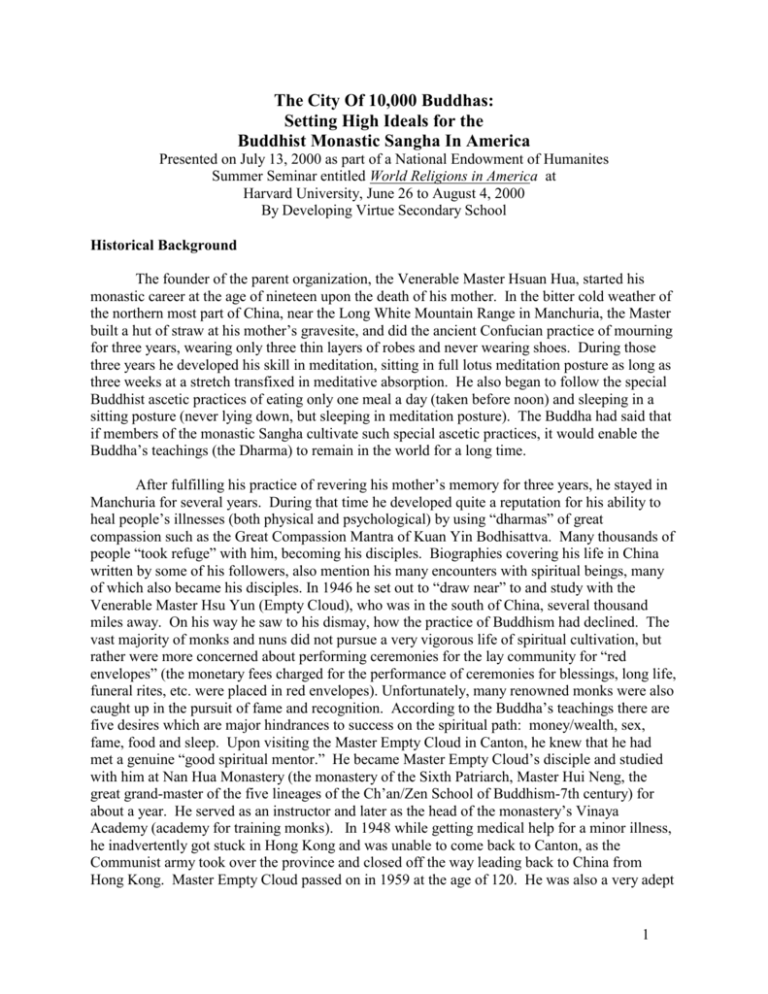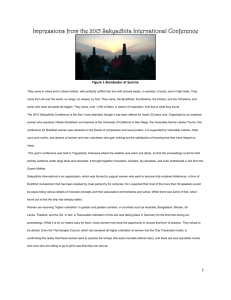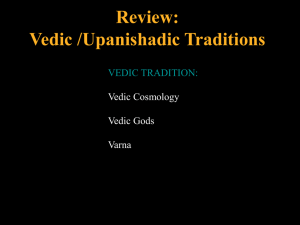Setting High Ideals for the
advertisement

The City Of 10,000 Buddhas: Setting High Ideals for the Buddhist Monastic Sangha In America Presented on July 13, 2000 as part of a National Endowment of Humanites Summer Seminar entitled World Religions in America at Harvard University, June 26 to August 4, 2000 By Developing Virtue Secondary School Historical Background The founder of the parent organization, the Venerable Master Hsuan Hua, started his monastic career at the age of nineteen upon the death of his mother. In the bitter cold weather of the northern most part of China, near the Long White Mountain Range in Manchuria, the Master built a hut of straw at his mother’s gravesite, and did the ancient Confucian practice of mourning for three years, wearing only three thin layers of robes and never wearing shoes. During those three years he developed his skill in meditation, sitting in full lotus meditation posture as long as three weeks at a stretch transfixed in meditative absorption. He also began to follow the special Buddhist ascetic practices of eating only one meal a day (taken before noon) and sleeping in a sitting posture (never lying down, but sleeping in meditation posture). The Buddha had said that if members of the monastic Sangha cultivate such special ascetic practices, it would enable the Buddha’s teachings (the Dharma) to remain in the world for a long time. After fulfilling his practice of revering his mother’s memory for three years, he stayed in Manchuria for several years. During that time he developed quite a reputation for his ability to heal people’s illnesses (both physical and psychological) by using “dharmas” of great compassion such as the Great Compassion Mantra of Kuan Yin Bodhisattva. Many thousands of people “took refuge” with him, becoming his disciples. Biographies covering his life in China written by some of his followers, also mention his many encounters with spiritual beings, many of which also became his disciples. In 1946 he set out to “draw near” to and study with the Venerable Master Hsu Yun (Empty Cloud), who was in the south of China, several thousand miles away. On his way he saw to his dismay, how the practice of Buddhism had declined. The vast majority of monks and nuns did not pursue a very vigorous life of spiritual cultivation, but rather were more concerned about performing ceremonies for the lay community for “red envelopes” (the monetary fees charged for the performance of ceremonies for blessings, long life, funeral rites, etc. were placed in red envelopes). Unfortunately, many renowned monks were also caught up in the pursuit of fame and recognition. According to the Buddha’s teachings there are five desires which are major hindrances to success on the spiritual path: money/wealth, sex, fame, food and sleep. Upon visiting the Master Empty Cloud in Canton, he knew that he had met a genuine “good spiritual mentor.” He became Master Empty Cloud’s disciple and studied with him at Nan Hua Monastery (the monastery of the Sixth Patriarch, Master Hui Neng, the great grand-master of the five lineages of the Ch’an/Zen School of Buddhism-7th century) for about a year. He served as an instructor and later as the head of the monastery’s Vinaya Academy (academy for training monks). In 1948 while getting medical help for a minor illness, he inadvertently got stuck in Hong Kong and was unable to come back to Canton, as the Communist army took over the province and closed off the way leading back to China from Hong Kong. Master Empty Cloud passed on in 1959 at the age of 120. He was also a very adept 1 meditator, sitting for three weeks at a time in meditative trance. Ch’an talks by Master Empty Cloud have been published and translated by Charles Luk (Ch’an & Zen Teachings). America, Land of the Beautiful After spending about 12 years in Hong Kong and establishing several monasteries there, the Venerable Master Hua came to America in 1962. He did not begin teaching Americans to any significant degree until the summer of 1968. At that time, one of his students, who was pursuing an advanced degree in Buddhist Studies at the University of Washington, invited a group of over 30 fellow students to attend an intensive 3-month seminar of study of the sacred text entitled the Shurangama Sutra with the Master. The seminar, which was held in-residence at a small temple the Master was staying at in San Francisco’s Chinatown, included a rigorous daily schedule of meditation and ceremonies. All the participants were Euro-Americans. At that time the Master began to lecture the Sutras (sacred texts) and other related Buddhist works every daya practice he continued for the next 20 + years. After the summer study and practice session, many of the students decided to make a long-term commitment to stay and study with the Master. Five individuals even expressed the wish to become ordained as monks and nuns. After training with the Master as novices for about a year, in 1969 the five went to Taiwan to receive the full ordination of Bhikshus and Bhikshunis. When they returned they in a sense became pioneers in American Buddhist monasticism. In 1970, as the community grew, a larger building was acquired in the Mission District of San Francisco. The previous mattress factory was remodeled and became Gold Mountain Ch’an Monastery. The monastery was also nicknamed the “ice-box” because the thick brick walls kept the unheated building icy cold during the winter. This was particularly noticeable during the 3 to 4 week intensive Ch’an meditation sessions held every winter (the meditation session ran from 3:00 AM to 12:00 midnight each day). The community at that time (1970-1976) had arranged to acquire the discarded vegetables from a local supermarket, and somehow managed to subsist on that as well as other unsolicited donations of food. In June of 1976 the Venerable Master acquired the City of 10,000 Buddhas, a former mental institution on 239 acres of land consisting of about 70 institutional size buildings located in the beautiful Ukiah valley in Mendocino County, 120 miles north of San Francisco. An additional 60 acres adjoining the grounds as well as another 189 acres of mountain land behind the City were acquired shortly thereafter. In October 1977 the Venerable Master moved his lecture series on the Flower Adornment Sutra to the City, and from that day forward only lectured Sutras at the City. He would spend three days at the City each week and the other four days at Gold Mountain Ch’an Monastery in San Francisco, where he lectured other Buddhist texts. Only then did most of the community move from Gold Mountain Ch’an Monastery and the International Translation Institute (the nun’s quarters in San Francisco donated to the Master by C. T. Shen in 1973) to the City of 10,000 Buddhas. Life at the City of 10,000 Buddhas & The Venerable Master’s Three Vows Life at the City follows the standard set long ago at Gold Mountain Ch’an Monastery back in 1970. Please refer to the attached daily schedule at the City of 10,000 Buddhas. Note that the schedule reflects two of the Venerable Master’s three great vows. The first vow is to 2 establish a firm foundation for the monastic Sangha in America, by having monasteries with a rigorous schedule and other opportunities for spiritual cultivation. Every day at the City the monks and nuns participate in a minimum of four hours of public ceremonies every day, and have the opportunity of doing as much as seven hours of these public rituals each day. Please note that there is absolutely no charge for these ceremonies or for any public lecture. Indeed, all the monks and nuns have vows of poverty, which prohibit them from having personal money or wealth. Most have taken a special vow to not even touch money (some do not have the vow of not touching money so that they can handle “temple” money in the performance of duties for the community). Also, the monks and nuns do not perform special rites for the lay community for money either inside or outside the monastery. However, temporary or permanent plaques in the names of loved ones are available in the Ancestral or Long Life Halls for a monetary fee that is given to the monastery- no monk or nun is allowed to receive personal donations of money. Following the example first begun by the Venerable Master while mourning his mother’s passing, all the monks and nuns also eat only one meal a day and sleep sitting up. Monks and nuns who are over 70 or who are ill eat twice or three times a day as they so wish, and sleep in whatever way they feel is comfortable. It is very important to note that the rigorous daily schedule at the City, as well as the restrictions on possessing personal money, and the practices concerning food and sleep, are all designed to invigorate the monastic Sangha, with the hope that it will remain strong and not fall into the same state of decline that occurred in China. The Master also set the model for eschewing the quest for fame and recognition. For example, beginning in 1970, the Association began publishing a monthly journal of Buddhist Studies called Vajra Bodhi Sea, which continues to be issued to this day (it was originally in English, but became bi-lingual in 1978). Although each issue was full of photos of activities of our monasteries, during his life, the Master would not permit his picture to appear in the journal, with the exception of group photos. Also, the Buddhist Text Translation Society published two volumes of the Master’s biography (covering his early life in China and then his years in Hong Kong), but he refused to have any involvement whatsoever with their publication. With his humility and penetrating insight, the Master epitomized the idea of the old, wise Chinese sage. The Tao Te Ching stresses the virtue of “hiding one’s light” in the following passage: Supreme good is like water. Water well benefits the myriad things, yet does not contend. It abides where the multitudes disdain. Therefore it is close to the “Way of Nature” (the Tao). In addition to the daily schedule of public ceremonies and Sutra lectures, the City also holds a three week Ten Thousand Buddhas Repentance Ceremony (April/May), a three week Flower Adornment Sutra Recitation Session (June/July), a four week Buddha Recitation and Ch’an Meditation Session (December/January), as well as week-long recitation or meditation sessions just about every month. These sessions, along with the daily schedule, enable each person to develop skill in a wide range of Buddhist practices. The sessions in particular help to nurture each one’s skill (kung fu) in meditation. Because of the wide range of both study and practice at the City, it is not possible to categorize it as belonging to only one particular school within Buddhism. All the major schools of Buddhism are studied and practiced at the City. 3 The second vow of the Venerable Master is to translate the major Sutras into English and other languages of the world. As mentioned before, the Master lectured the Sutras daily for over 20 years. Most important is the fact that he spent 11 of those 20+ years lecturing the kings of Sutras, the Great Means Expansive Buddha Flower Adornment Sutra and the Lotus Flower of the Wondrous Dharma Sutra, as well as the Shurangama Sutra. It is said that a student should study these three Sutras in order to understand the full scope of the Buddha’s teachings and unfold his or her’s inherent wisdom. The Buddhist Text Translation Society, the translation arm of the parent corporation called the Dharma Realm Buddhist Association (DRBA), has been publishing translations of the major Buddhist Sutras with extensive inter-linear explanations since 1970. To date the Society has published over 200 books in English, as well as translations in Spanish and Polish. The Society has published well over 200 works in the original Chinese as well. Many Sutras and other Buddhist works, lectured by the Venerable Master, will be published in the future. As the Chinese Buddhist Canon is the oldest and most complete canonical source for the Mahayana Buddhist tradition, the work of training skilled translators is an on-going task at the City. The City and all branch monasteries of DRBA have bi-lingual lectures on the Sutras every day to both deepen each student’s understanding of the Buddha’s teachings as well as help develop each one’s ability to do translation work. The third vow of the Master is to develop Buddhist educational institutions. In 1974 DRBA established an elementary school, and later added a high school. In 1976 Dharma Realm Buddhist University was established. These educational institutions are all located at the City of 10,000 Buddhas. The university also has a program in Berkeley in conjunction with the Graduate Theological Union. The Master has said that another reason for the decline in Buddhist practice in China, which actually began many hundreds of years ago during the Sung Dynasty, was that Buddhism in China never developed an organized system of educational institutions. By this he meant institutions for the general public as well as for monastics. Our branch monastery in Calgary, Avatamsaka Monastery, is planning to open another elementary school this year. As noted on their stationary the two elementary schools at the City, Instilling Goodness Boys School and Instilling Goodness Girls School stress the cardinal virtue of reverential obedience to one’s father and mother. The Developing Virtue Boys School and Developing Virtue Girls School, the two high schools, stress the virtue of faithfulness to one’s country in addition to filial reverence. Summary And Conclusion When we look at how Buddhism will develop and remain a strong, vibrant and positive force in America, it is very important to apply the lessons that have been learned from history. Why has Buddhism been in a state of decline in so many countries in Asia, particularly during this last century? What qualities did Buddhism have during its “golden age” in these countries (i.e. the T’ang Dynasty in China)? Is it possible to develop Buddhist communities that are very strong in all three of the major components of the Buddha’s path: ethics, meditative practice, and knowledge of the Sutras? The Sutras, particularly the Ultimate Extinction of the Dharma Sutra, mention that the strength or decline of the Buddha’s teaching in the world is inextricably tied to the strength or decline of the monastic Sangha- how should Buddhists in America interpret this teaching? When one ponders these questions, one can understand the rationale for establishing a rather rigorous monastic community as has been done at the City of 10,000 Buddhas. Hopefully, the ideals established at the City will be more perfectly realized in the future, and it will be a good influence on the many other Buddhist groups that are also developing now in America. 4 At that time the Buddha, by means of his unobstructed pure “eye of wisdom”, contemplated all living beings everywhere throughout the Dharma-realm and spoke these words: “Amazing! Truly amazing! How it is that all these living beings are replete with the Buddha’s wisdom. Yet they are ignorant and confused, and do not know or see it. I should teach them the Noble Path to cause them to forever separate from false thinking and attachments, so that they will see the Buddha’s vast wisdom within themselves, which is no different from the Buddha.” (First words spoken by the Buddha upon his Awakening from the Flower Adornment Sutra) 5









